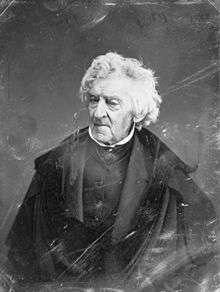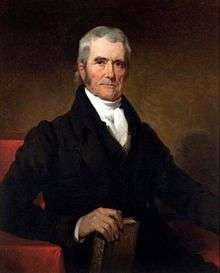William Cranch
| William Cranch | |
|---|---|
 | |
| Chief Judge of the United States Circuit Court of the District of Columbia | |
|
In office February 24, 1806 – September 1, 1855 | |
| Appointed by | Thomas Jefferson |
| Preceded by | William Kilty |
| Succeeded by | James Dunlop |
| Judge of the United States Circuit Court of the District of Columbia | |
|
In office March 3, 1801 – February 24, 1806 | |
| Appointed by | John Adams |
| Preceded by | Seat established |
| Succeeded by | Allen Duckett |
| Reporter of Decisions of the Supreme Court of the United States | |
|
In office 1801–1815 | |
| Preceded by | Alexander Dallas |
| Succeeded by | Henry Wheaton |
| Personal details | |
| Born |
July 17, 1769 Weymouth, Massachusetts Bay, British America |
| Died |
September 1, 1855 (aged 86) Washington, D.C., U.S. |
| Resting place | Congressional Cemetery |
| Political party | Federalist |
| Education | Harvard University (BA) |
William Cranch (July 17, 1769 – September 1, 1855) was an American attorney and judge. He was notable for his role as the second reporter of decisions of the Supreme Court of the United States and his long tenure as a judge on the United States Circuit Court of the District of Columbia.
Born in Weymouth, Massachusetts to clockmaker and legislator Richard Cranch and Mary (Smith) Cranch, William Cranch was a nephew of Abigail Adams. Cranch was educated in Weymouth, and graduated from Harvard College in 1787. He studied law, attained admission to the bar in 1790, and relocated to Washington, DC. There he worked as the legal agent for a real estate company.
In 1800, Cranch was named federal Inspector of Public Buildings, an appointment he received from his uncle, President John Adams. In 1801, Adams appointed Cranch as an associate justice of the United States Circuit Court of the District of Columbia. He served until 1806, when he was appointed as the court's chief justice; Cranch served in this position until his death.
Cranch also served as Reporter of Decisions for the United States Supreme Court from 1801 to 1815. The second individual to hold this post, Cranch served voluntarily, and produced his reports at his own expense. In addition to his work as a jurist, Cranch was also an author; he wrote a biography of John Adams. He also published reports on his court's decisions. Cranch died in Washington in 1855, and was buried at the Congressional Cemetery in Washington.
Early life
Born in Weymouth, Massachusetts, William Cranch was the son of Richard Cranch, an English-born clockmaker and Massachusetts legislator and judge, and his mother was Mary Smith, the elder sister of Abigail Smith Adams. His uncle by marriage was John Adams, who was elected as the second President of the United States. His first cousin was John Quincy Adams, the sixth President. William Cranch was educated in Weymouth, and prepared for college by studying with the Reverend John Shaw of Haverhill. He graduated from Harvard College with honors in 1787, studied law with Boston attorney Thomas Dawes, and was admitted to the Massachusetts bar in 1790.
Career
From 1791 to 1800, Cranch worked as a legal agent for a real estate firm in Washington. There was great speculation going on as the developing city had only recently been designated as the national capital. When land speculation bankrupted him, his uncle John Adams rescued him by appointing him in 1800 to be Inspector of Public Buildings. Then, in 1801, Cranch was selected as one of the two associate justices for the District of Columbia Circuit Court. The nomination was put forth on February 28, 1801, and Cranch was confirmed by the United States Senate on March 3, 1801, receiving his commission the same day.
In 1805, Cranch became a member of the first board of Trustees for Public Schools and served on that board for 7 years.[1]
On February 21, 1806, President Thomas Jefferson elevated Cranch to Chief Judge of the Circuit Court, that seat having been vacated by William Kilty. Cranch's elevation was confirmed by the United States Senate on February 24, 1806. In this role he swore in two presidents of the United States, John Tyler (in 1841) and Millard Fillmore (in 1850). Each succeeded to the presidency upon the death of his predecessor. Cranch held the position of Chief Judge in the District until his death in 1855.
While serving as a Circuit judge, Cranch also served as the second reporter of the Supreme Court from 1801 to 1815. At the time, the reporter was an unofficial post and he used his own funds to produce the reports. Cranch took on the responsibility because of his respect for precedent. He was slow in producing his reports of cases and their accuracy was questioned.
During his tenure on the court, Cranch published a biography about his uncle John Adams. He also edited his own volume of reports on civil and criminal cases from the District.[2]
On February 3, 1826, the Columbian College (now George Washington University) board of trustees elected Cranch and William Thomas Carroll, Esq., as the first law professors. On June 13 of the same year, with President John Quincy Adams in attendance, Professor Cranch delivered the first law lecture in the court room of the City Hall. [3]
Cranch died in Washington, DC on September 1, 1855. He was buried at Congressional Cemetery.[4]
Legacy and honors
- In 1871, the Cranch Public School Building, named in his honor, opened at the southwest corner of 12th and G, SE in Washington, DC. It was demolished in 1949.[1][5]
- Cranch was elected an Associated Fellow of the American Academy of Arts and Sciences in 1809.[6] *He was elected as a member of the American Antiquarian Society in 1813.[7]
- During the 1820s, Cranch was a member of the prestigious society, Columbian Institute for the Promotion of Arts and Sciences, who counted among their members presidents Andrew Jackson and John Quincy Adams, and many prominent men of the day, including military officers and officials of government service, and leaders of medical and other professions.[8]
Notable decisions
Cranch is known for several decisions that set a precedent for jury nullification (allowing a jury to nullify an "unjust" law and refuse to convict), including:
- United States v. Fenwick, 25 F. Cas. 1062; 4 Cranch C.C. 675 (1836): Right to make legal argument to jury.
- Stettinius v. United States, 22 F. Cas. 1322; 5 Cranch C.C. 573 (1839): Right to make legal argument to jury.
Cranch also handed down important precedent in a variety of topics, for example in a criminal law case regarding the mens rea of intoxication, Cranch wrote:
It often happens that the prisoner seeks to palliate his crime by the pleas of intoxication; as if the voluntary abandonment of reason ... were not, of itself, an offense sufficient to make him responsible for all of its consequences.[9]
Family
William Cranch married Nancy Greenleaf. They had four sons; of these, three: Christopher, Edward, and John Cranch, all became painters.[10]
Their daughter Abigail Adams Cranch married William Greenleaf Eliot. They were the parents of Henry Ware Eliot and the grandparents of poet T. S. Eliot.
Notes
- 1 2 Twenty-fifth Report of the Board of Trustees of Public Schools of the City of Washington, 1871-'72. M'Gill & Witherow,. 1872. p. 136.
|access-date=requires|url=(help) - ↑ William Cranch, (United States. Circuit Court (District of Columbia) Reports of Cases Civil and Criminal in the United States Circuit
- ↑ "Probing the Law School's Past: 1821-1962". gwu.edu. Retrieved 4 May 2015.
- ↑ William Cranch at Find a Grave
- ↑ "12th and G Street SE". The Ruined Capitol. Retrieved 21 June 2016.
- ↑ "Book of Members, 1780–2010: Chapter C" (PDF). American Academy of Arts and Sciences. Retrieved September 8, 2016.
- ↑ "MemberListC". American Antiquarian Society. Retrieved 4 May 2015.
- ↑ Rathbun, Richard. The Columbian institute for the promotion of arts and sciences: A Washington Society of 1816-1838. Bulletin of the United States National Museum, October 18, 1917. Retrieved 2010-06-20.
- ↑ William Cranch, White, Edward G. 1988. The Marshall Court and Cultural Change, 1815–1835. Vols. 3 and 4, History of the Supreme Court of the United States, 1815–1835. New York: Macmillan
- ↑ David Bernard Dearinger; National Academy of Design (U.S.) (2004). Paintings and Sculpture in the Collection of the National Academy of Design: 1826-1925. Hudson Hills. ISBN 978-1-55595-029-3.
References
- William Cranch at the Biographical Directory of Federal Judges, a public domain publication of the Federal Judicial Center.
- White, Edward G. 1988. The Marshall Court and Cultural Change, 1815–1835. Vols. 3 and 4, History of the Supreme Court of the United States, 1815–1835. New York: Macmillan.
- Witt, Elder. 1990. Guide to the U.S. Supreme Court. 2d ed. Washington, D.C.: Congressional Quarterly
Further reading
- William Cranch, O Say Can You See: Early Washington, D.C., Law & Family (accessed Nov. 4, 2015) This person page networks the involvement of William Cranch in the legal records and proceedings of the Circuit Court for the District of Columbia between 1800 and 1855.
External links
| Wikimedia Commons has media related to William Cranch. |
| Wikiquote has quotations related to: William Cranch |
| Legal offices | ||
|---|---|---|
| Preceded by Alexander Dallas |
Reporter of Decisions of the Supreme Court of the United States 1801–1815 |
Succeeded by Henry Wheaton |
| New seat | Judge of the United States Circuit Court of the District of Columbia 1801–1806 |
Succeeded by Allen Duckett |
| Preceded by William Kilty |
Chief Judge of the United States Circuit Court of the District of Columbia 1806–1855 |
Succeeded by James Dunlop |
